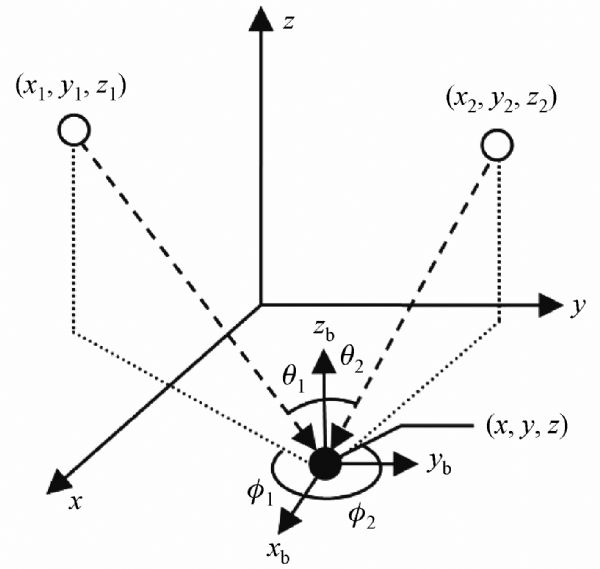The improved AOA accuracy and FOV of the camera architecture comes at the cost of an increased difficulty in identifying optical beacons. The frequency identification method used for the multi-photodiode architecture is difficult to implement with the camera architecture due to the low frame rate of most current image sensors. While newer cameras such as the GoPro Black are capable of capturing slow-motion video at frame rates up to 240 Hz, frequency identification is still challenging due to a user’s ability to see light modulation up to 65 Hz [
38]. This frequency, called the flicker frequency, limits the minimum frequency and minimum frequency spacing. To overcome this limitation, the techniques in Ref. [
21] can be applied. There, two additional capabilities of the camera architecture are leveraged to identify optical beacons. First, the camera architecture can spatially separate incoming signals meaning that optical beacons can reuse identifier frequencies so long as each optical beacon has a unique combination of identifier frequencies, i.e., frequency 1 or frequency 2 or both frequencies 1 and 2. This was not possible in the photodiode architecture since each photodiode measured the incoming signals from all beacons simultaneously. Second, most image sensors today can detect color using separate pixels that are sensitive to red, green, and blue (RGB) light. Also, since certain white light LEDs are comprised of separate RGB diodes, the system can transmit different identifier frequencies on different colors of the same optical beacon, e.g., frequency 1 on red, direct current (DC) on green, and both frequencies 1 and 2 on blue. In this system, a DC signal acts as no frequency. Combining these two identification methods with the frequency based method, the authors in Ref. [
21] arrived at the color-frequency detection method. In this method, given a certain number of frequencies,
nf, and a certain number of colors,
nc, the number of unique identifiers is
. This is because each optical beacon must have at least one identifier frequency on at least one color. The authors of Ref. [
21] had a camera with a frame rate of 187 Hz, which restricted the number of possible identifier frequencies to two. However, in that work, it was assumed that frequencies above the Nyquist frequency could not be used due to aliasing. Recently, we have now found that this is not the case. By under-sampling higher frequencies, we can increase the number of useable identifier frequencies so long as the image sensor in the optical receiver does not have an antialiasing filter and care is taken to ensure that any alias frequencies arising from the under-sampling of the identifier frequencies do not fall too close to other identifier frequencies. This allows the system to use identifier frequencies up to and even above the sampling rate. We call this new technique under-sampled frequency-color identification for optical beacons.












